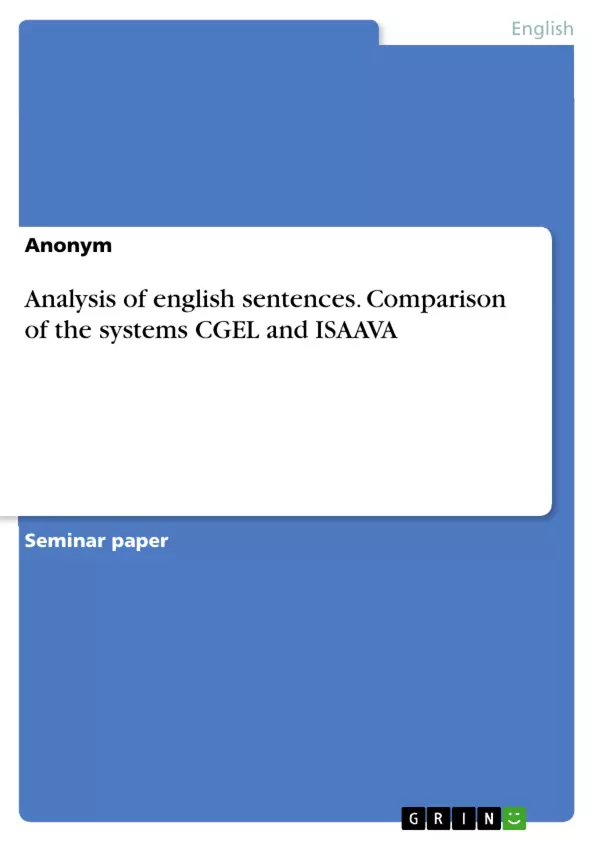Where grammatical rules derive from, how they are linked, whether they are similar in different languages or not, whether we are born with it or acquire it as infants – these are questions, linguists worldwide have been dealing with for decades. Many syntactical approaches are the result of these researches. Two of them, the Comprehensive Grammar of the English Language (CGEL) and the Introduction to Syntactic Analysis – A Valency Aproach (ISAAVA), will be compared in this paper.
Table of Contents
- Introduction
- A Comprehensive Grammar of the English Language (CGEL)
- CGEL's Clause Constituents or the First Functional Level of Analysis
- Phrases and Phrase Constituents or the First Formal and Second Functional Level of analysis
- Word Classes or the Second Formal Level of analysis
- Introduction to Syntactic Analysis - A Valency Approach (ISAAVA)
- Comparison of a CGEL-Analysis and an ISAAVA-Analysis of an example sentence
- Sentence analysis
- Differences and problematic aspects in the two approaches
- Prepositions vs. Particles
- Analysis of “fended off”
- Determiners vs. Determiner-pronouns
- Conclusion
Objectives and Key Themes
This work aims to compare two prominent approaches to English sentence analysis: the Comprehensive Grammar of the English Language (CGEL) and the Introduction to Syntactic Analysis - A Valency Approach (ISAAVA). The comparison focuses on the different levels of analysis employed by each approach, highlighting their strengths and weaknesses.
- Grammatical analysis of English sentences
- Comparison of constituency-based and valency-based approaches
- Different levels of analysis: clause constituents, phrases, and word classes
- Problematic areas of analysis: prepositions vs. particles, determiners vs. determiner-pronouns
- Applications of grammatical analysis in language teaching and research
Chapter Summaries
The first chapter introduces the concept of grammar and its significance in language learning and linguistic research. It discusses the historical origins of the term “grammar” and provides an overview of the diverse approaches to syntactic analysis, highlighting the two main approaches, CGEL and ISAAVA, that will be compared in the subsequent chapters.
Chapter two offers a comprehensive overview of CGEL, examining its hierarchical approach to sentence analysis, which involves classifying grammatical units based on their form and function. It outlines the five key elements of clause structure in CGEL: subject, verb, object, complement, and adverbial, and further delves into the classification of phrases and word classes within the framework of CGEL.
Chapter three provides an introduction to ISAAVA, focusing on its valency-based approach to syntactic analysis, which emphasizes the valency of verbs and the roles of their arguments in a sentence. It explores the core concepts of ISAAVA, such as valency frames, argument structure, and the relationship between verbs and their complements.
Chapter four presents a direct comparison of CGEL and ISAAVA by analyzing a specific example sentence. This comparison highlights the differences and problematic aspects of both approaches, particularly in areas such as the distinction between prepositions and particles and the analysis of specific grammatical constructions.
Keywords
This work explores the core concepts of grammar, sentence analysis, constituency-based approach, valency-based approach, CGEL, ISAAVA, clause constituents, phrases, word classes, prepositions, particles, determiners, determiner-pronouns, grammatical units, and syntactic analysis.
- Arbeit zitieren
- Anonym (Autor:in), 2013, Analysis of english sentences. Comparison of the systems CGEL and ISAAVA, München, GRIN Verlag, https://www.hausarbeiten.de/document/1026272


